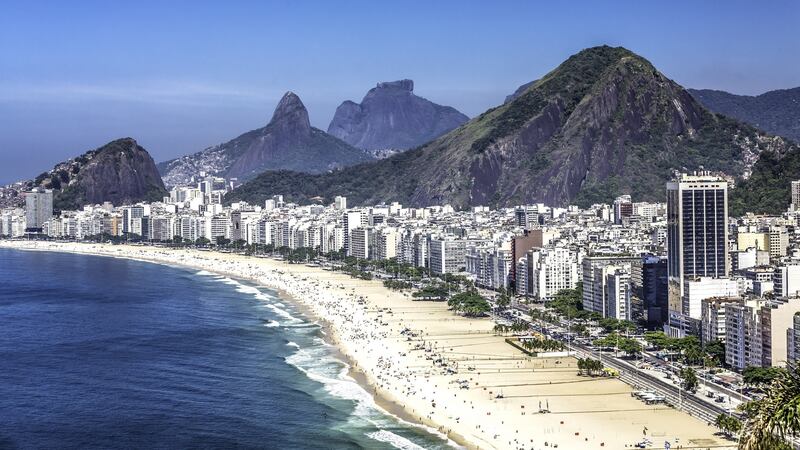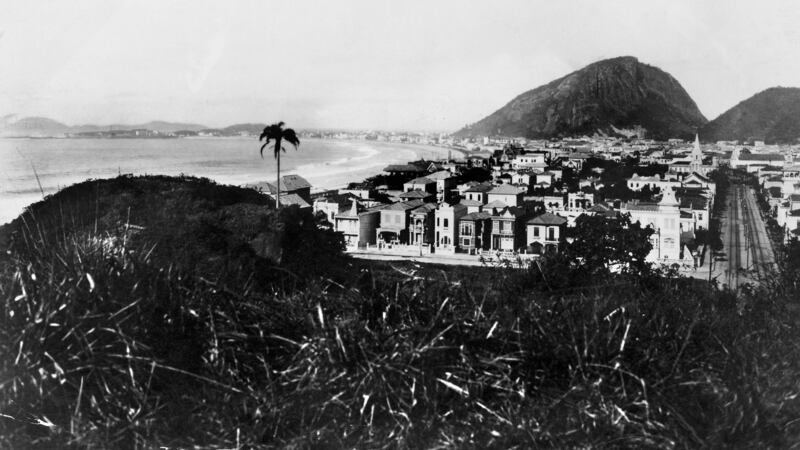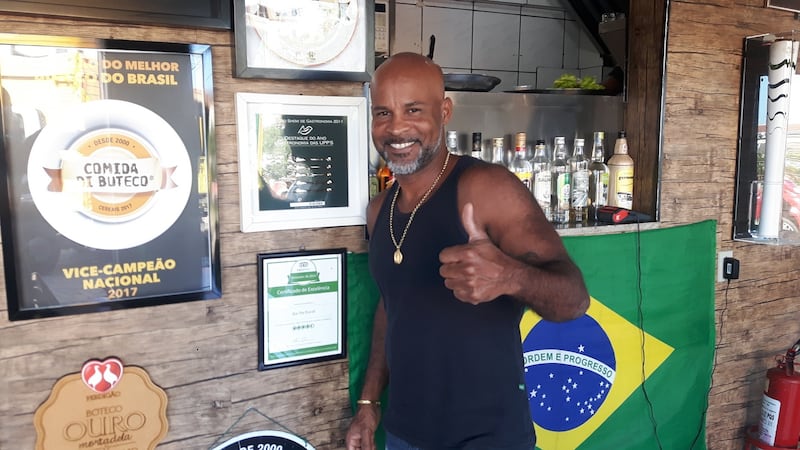It is another glorious winter morning in Rio de Janeiro and though only 8am, the mercury has already zipped past 20 degrees, and the few clouds in the sky are strictly decorative fluff.
In Copacabana, the daily migration from the neighbourhood's densely occupied city blocks to its world-famous beach is well under way, a steady stream of pilgrims in togs, bikinis and flip-flops emerging from apartment buildings to make the short journey to the legendary strip of sand.
Among those crossing over the sweeping beachfront Avenida Atlântica are Nilza and Aurelia, two of the neighbourhood’s resident army of retirees, both looking fabulously glamorous in their wide-brimmed sun-hats and designer sunglasses. For both of them this is a daily ritual.
0 of 4
“The beach is everything!” they offer with the exuberant certainty typical of cariocas, as Rio’s natives are called, when asked what they love about the place. “It is a blessing that every day you have this sunshine, this ocean. It reinvigorates me. I love Copacabana!” explains Nilza.
It is not hard to see why. Brazilians like to claim God as one of their own and “Copa”, as it is known, might well be proof they are right.
The natural beauty of the place is staggering, an absurd riot of tropical splendour which may have been created on the eighth day when, all the sober work done, God decided to cut loose.
Located in Rio’s affluent southern zone, the crescent-shaped beach (actually two beaches, Copacabana seamlessly sharing the bay with the smaller Leme Beach) gently curves along for 4km, its wide sands protected by two headlands.

Depending where you are along the beachfront you will be able to see some of Rio’s famous stone monoliths such as the Sugarloaf, Two Brothers or, further off, the table-topped Gávea Rock. And rearing up behind the neighbourhood’s high-rises are the mountains of Tijuca, the world’s biggest urban forest, capped by the iconic Christ Redeemer statue.
Naples and San Francisco? Eat your hearts out.
Income
But while people have come from all over the world to drink this in – and some, having done so, can never drag themselves away again – Copacabana is not a tourist destination as such. Tourists there are, and these visitors remain a major source of income for the local economy.
Yet Copacabana remains principally a working city beach, its moods and rhythms dictated by its principle users – local cariocas. “It is funny that people come here for holidays because this is just our day-to-day reality. When I want to go on a beach holiday to relax I go elsewhere,” says Horácio Magalhães, president of the Society of Friends of Copacabana.
Hemmed in by hills on all sides, Copacabana and Leme cram around 160,000 people into just 5sq km. It was only in 1892 when engineers punched a tunnel through the hills that the city’s tram companies could properly connect a scratch of land, home to fishermen’s shacks, to the rest of Rio.
Thereafter it grew rapidly, exploding in the 1930s when it became a kind of showroom for the new middle class created by gathering industrialisation and urbanisation. By the 1950s the neighbourhood entered its golden age, when it was the birthplace of bossa nova, the new sound that merged poetry, samba and jazz and swept the world.

"This was a new Brazilian urban way of life that did not exist before and it first emerged here. Copacabana therefore came to symbolise urban Brazil, and it is in Copa you see the first cultural manifestations of this new urban middle class," says urbanist Washington Fajardo, former president of the Rio institute charged with preserving the city's architectural and cultural patrimony.
With few public spaces in Copa, the beach became a central stage for these new manifestations. “Originally it was ignored by property developers when first selling the neighbourhood but the beach came to compensate for the lack of large open urban areas elsewhere,” explains Washington.
Urban culture
Having done so, it in turn helped shape this new urban culture. From early morning to late at night the beach and its Unesco-preserved promenade, laid out by Brazilian landscape architect Roberto Burle Marx, is a zone of intense social activity. Even at 8am, as Nilza and Aurelia make their way past the river of morning joggers, skaters and cyclists on to the sand, there are already paddlers splashing around in the shallows, while pods of long-distance swimmers further out get through several kilometres before starting the rest of their day. Surfers share the wave breaks with the stand-up paddlers, while closer to the horizon are the serious kayakers.
The sand is just as busy. In between those who have already flopped into hired deckchairs there are numerous games of beach tennis and circles playing keepie-uppie with footballs. Further back towards the avenue are clearly demarcated beach volleyball courts, where several world champions first honed their skills.
All day groups of friends, despite no prior arrangement, will meet up at their habitual spots of beach to chat or – after the sun goes down – sip beer at one of the kiosks on the promenade where gym stations help the city’s muscleheads stay in shape. “For cariocas the beach is not a natural space or somewhere to switch off – it is a social place, an extension of Rio’s social life,” says Washington.

Many other Brazilians see the carioca obsession with the beach and exercising their bodies on it as further proof of the city’s supposed narcissism. But Camila Leal, one of the army of personal trainers licensed by city hall to offer exercise classes on Copacabana’s sands, does not see it that way.
“Cariocas are not so much concerned with the cult of the body rather than with embracing a healthy lifestyle. Rio with this sea and sand in front of you is very propitious for doing exercises. It calls out to you to be more sporty,” she says.
But she adds a caveat: “Cariocas do have greater freedom of expression in terms of their bodies compared to other Brazilian cities like São Paulo because of the beach. Here you dress less formally. You can just put on a bikini when leaving the house. Without a beach São Paulo is a stuffier city, for example.”
This sensuousness, which seems almost inevitable given the topography, has earned Copa in some prissy quarters a reputation for sexual licentiousness. And there is a sleazy sex trade on one or two blocks.
But more important is the culture of informality, especially marked in Copacabana, that beach culture has bequeathed to Rio. This explains, say, the city’s disinterest in fine dining as opposed to its fixation on finger food served from hole-in-the-wall pavement bars.
Everyone comes together to play on the beach, to socialise. There everyone is equal.
This informal culture has given rise to the notion of the beach creating a “democratic space” that allows for greater mixing between members of a society otherwise riven by social and racial divisions.
“My regular volleyball game has lawyers and engineers playing with residents from Pavão [a favela, or slum, overlooking Copacabana],” says Horácio of the Society of Friends of Copacabana. “Everyone comes together to play on the beach, to socialise. There everyone is equal. No-one is better or worse than anyone else, apart from when the subject is volleyball.”
Copacabana’s steep hills were ignored by developers and so quickly occupied by poor, mainly black Brazilians who worked but could not afford to live in the new neighbourhood. This proximity gives Copa’s social inequality an unusually intimate quality.
Right alongside well-heeled high rise apartments is the favela of Cantagalo. Local surfer and all-round beach aficionado Bruno Mortagua agrees the beach is one space that unites people from these two worlds living cheek by jowl.
“Being black I have suffered from prejudice,” he says. “Sometimes when you walk into a shop you can feel the staff looking at you differently. But you don’t get this on the beach. There everyone is in togs or bikinis so you cannot tell whether they are rich or poor as easily. There no-one looks strangely at you.”
But few deny that the idea of the “democratic” beach does not fully capture the complex nuances of relations between the “hill” and the “asphalt”, as Rio’s divide between its favelas and the formal city is called.
In the favela of Babilônia perched above Leme, local community leader Cosme Campos tells of the discrimination and racial insults some of the favela’s residents suffer when they go down the few blocks to the beach. “Many of those living down there think they own it, and those who live in the favela are discriminated against just for being ‘favelados’,” he says, before quickly adding: “But there are also many friendships between residents of the asphalt and hill forged on the beach.”
Fear of crime
Cosme says the discrimination directed at favela residents is linked to fear of crime, the spectre of which haunts Rio’s tropical idyll. On the sand this takes the form of fear of arrastões, practised by gangs of kids who charge down crowded beaches robbing anything they can while spreading panic. Cosme is adamant the kids who do this come from slums in far-flung suburbs: “Favela residents here just don’t do this kind of thing but we suffer discrimination and police violence as a result.”
Insecurity is on the rise again in Rio. The effort to break the control exercised by the city’s drug gangs over its favelas ahead of the city hosting the World Cup and Olympics has gone into reverse. The gangs are resurgent, and with the state government bankrupt and much of its political leadership in jail for corruption, the police have proved unable or unwilling to respond. Earlier this year the army was sent to prevent the situation getting out of control, but shoot-outs have continued to spook residents and tourists alike.
The result has been a widening, once again, of the divisions between residents of Copacabana’s favelas and those living down on the asphalt. The army has sporadically sealed off many favelas, frisking locals going in and out, even going through the bags of primary school kids looking for arms and drugs.

“This kind of approach just reinforces social divisions,” says David Vieira Bispo, who comes from Babilônia’s twin favela of Chapéu Mangueira. After it was “pacified” in 2009 he opened a bar in the community. Being just a few blocks from the beach, it would attract up to 800 people on busy days, including many tourists and asphalt residents, drawn by his award-winning bar food and live samba.
But having already had to let some staff go he is afraid he might have to close up entirely. “Now many people are afraid once again to go up into the favelas,” David explains. “I have regular clients ringing me before they come up asking me if it is safe to do so. This is not how we want our city to be. I feel like everything I have built up is going down the drain. It is sad what’s happening.”
Like David, Cariocas’ natural exuberance might still be intact but they are furious about the current state of their city. The army intervention has also hit business at beachfront hotels and restaurants. Ordering soldiers on to the street is not exactly the sort of assurance many tourists seek when selecting a holiday destination.
Yet despite it all, Copacabana still draws plenty of others to it. Some come and snobbishly dismiss it as something of a dump, its best days behind it. But they just fail to see its genius. It remains Rio's – perhaps Brazil's – most original, distinctive, idiosyncratic, diverse neighbourhood, brimming with personality and an attitude its richer but duller neighbours Ipanema and Leblon cannot match.
And even if all that leaves you unmoved there are always the views. And if they don’t move you? Well, then the problem is definitely with you.
















